Bakeries Under the Rubble: The Bombing of the al-Maghazi al-Jadeed Bakery

The economic conditions in the Gaza Strip are deteriorating, and food insecurity is on the rise, as a direct result of the escalation of hostilities since October 2023. People in the Strip are suffering through a stifling food crisis and a food funding deficit, as well as the obliteration of infrastructure and food sources, and the restriction and prevention of access to humanitarian aid.
UNICEF states that the deteriorating conditions in the Gaza Strip raise concerns of acute malnutrition and death, in a manner exceeding famine thresholds for acute food insecurity. A UNICEF statement — based on the latest Integrated Food Security Phase Classification (IPC) report — warned that “acute food insecurity puts all children under five in the Gaza Strip at high risk of severe malnutrition and preventable death.”
Bakeries in the Gaza Strip — which were responsible for a part of the Strip’s food needs — endured their fair share of destruction by being bombed directly or being damaged and having to stop operations. The World Food Programme (WFP) stated that airstrikes have caused many of the bakeries it works with to distribute bread to the displaced in Gaza to shut down, adding that approximately 2.2 million people need food aid.
The al-Maghazi al-Jadeed bakery was one of the bakeries damaged by direct bombardment in the Gaza Strip. This raises questions surrounding the commitment of warring parties to international humanitarian law — particularly in light of Israel ordering Gazans to migrate south.
This investigation seeks to understand the humanitarian and legal implications of this targeted attack by relying on precise geographical analyses and witness accounts from the field published online. The aim is to evaluate whether it constitutes a violation of the international laws and treaties aimed at protecting civilians and civilian infrastructure during times of conflict.
About the Bakery
The al-Maghazi al-Jadeed Bakery, situated in the Gaza Strip, is a crucial bread distribution point for thousands of families who either reside in al-Maghazi camp or were displaced by Israel's relentless bombardment since October 2023.
In a statement, the Palestinian Government Media Office announced that Israeli shelling completely destroyed the bakery on the evening of October 24, 2023, adding that the bakery had received flour and fuel from UNRWA just hours prior. A few hours after the distribution of these supplies, al-Maghazi Bakery was targeted and destroyed, according to the statement and the testimony of bakery worker, Ahmed Ziyara. Ziyara stated that UNRWA provided the bakery with flour and gas so that it “would start today by selling a bundle of bread for four shekels,” but the bombing prevented these efforts.
UNRWA’s thirteenth situation report on the Gaza Strip and the West Bank, including East Jerusalem from October 23, 2023, sheds light on the humanitarian situation in the Gaza Strip. Published just one day prior to the attack on al-Maghazi, the report announced that UNRWA continued to supply bakeries with flour, which allowed 30 bakeries in the Strip to provide families with bread at half the cost. This lends itself to the possibility that al-Maghazi was one of the 30 bakeries supported.
All of this confirms that the al-Maghazi bakery played a vital role in ensuring food security in the Gaza Strip. As the residents of Gaza continue to face “desperate conditions,” in the words of Cindy McCain, head of the World Food Programme, the loss of al-Maghazi bakery compounds the escalating humanitarian crisis. As the conflict intensifies and food and water run out, these events underscore the urgent need for the international community to shoulder its responsibilities in protecting civilians and civilian infrastructure in times of war.

Reports of al-Maghazi bakery’s bombing started to surface late in the evening of October 24. At precisely 23:42 Gaza time, Hams Mohammad, a civilian residing in Gaza, posted about the incident on Facebook, describing it as “a massacre in the bombing of al-Maghazi bakery.”
To verify the exact time of the incident and the local time of first reports, we extracted the timestamp ID of Hams Mohammad’s Facebook post, believed to be the first report of the incident on Facebook, by using the Inspect feature to examine the metadata of the post. We then searched through the metadata for the phrase story":{"creation_time, which comes right before the post’s timestamp ID.
The timestamp ID of Hams Mohammed’s Facebook post appears as (1698180146). Using the tool EpochConverter to convert this timestamp into the time in Gaza City leads to: Thursday, October 24, at 23:42:26 Gaza City time.
Timing of the Incident

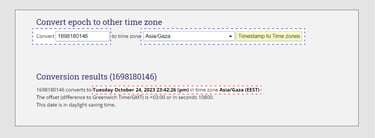
A screenshot of the “Inspect” step on Hams Mohammad's Facebook post, and a screenshot of the EpochConverter tool, showing the timestamp of Hams Mohammed’s Facebook post. Retrieved in January 2024.
Besides verifying the timestamp of what could be the first post to report the incident, a series of social media posts reporting the targeting of the al-Maghazi al-Jadeed bakery were analyzed and cross-checked to understand the chronological sequence of events. Minutes after the first report was published on Facebook, al-Ghad TV reporter Mahmoud al-Louh reported the bombing in a Telegram post at 23:47, indicating that some people were martyred and others injured. A minute later, at 23:48, he added an update confirming that six martyrs fell as a result of the bombing. At the same time, the al-Aqsa channel posted about the attack on Telegram at 23:48, announcing four dead after the “targeting of a bakery in al-Maghazi.”
Other reports followed, by Sama News Agency and journalist Muthanna al-Najjar, confirming the incident and human losses in the wake of the attack. Around five minutes before midnight, Khalil al-Ghafari, a citizen residing in al-Maghazi, posted additional details on Facebook, indicating that the house of the al-Barbarawi family in Souk al-Maghazi was targeted, and the nearby bakery was destroyed. Finally, at 00:52 (the following day), the al-Maghazi Now Facebook page published photographs documenting the total destruction of al-Maghazi al-Jadeed Bakery and adjacent buildings. An announcement accompanied the photographs: “Tremendous destruction befell al-Maghazi al-Jadeed Bakery, Hammadah Ice Cream Parlor, Aabed Money Exchange, and many shops and residential buildings caused by the bombing of the al-Barbarawi family’s house.”
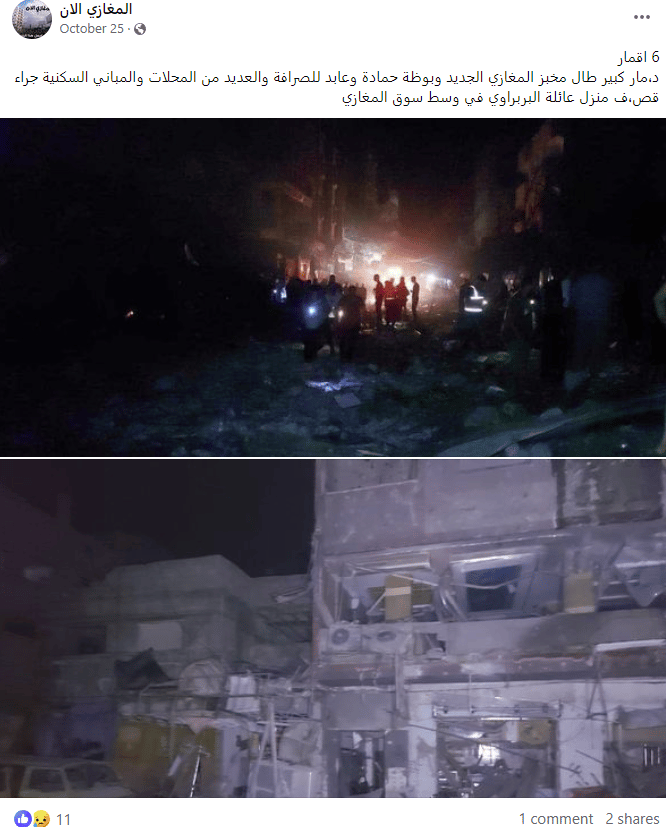

These cross-checked, early reports of the incident align with the testimony of Ahmed Ziyara, one of the workers at the targeted bakery. Ziyara informed al-Ray News Agency that the attack occurred while the workers were on a break between 22:00 and midnight. Upon their return, they found the bakery completely destroyed. This is supported by the bakery owner’s testimony, made in an interview with Al Araby. The owner said that they left the bakery at 21:00 and were about 50 meters away from it; ten minutes before they returned at 23:00 to start working for the next day, they were surprised to find the bakery had been bombed.
These narratives — in addition to verifying the timestamp, corroborating information, and matching it with eyewitness accounts — reveal a consecutive sequence of events that provide possible chronological context reflecting the rapidly developing news around, and community response to, the bombing of the al-Maghazi bakery and its immediate impact on local residents.
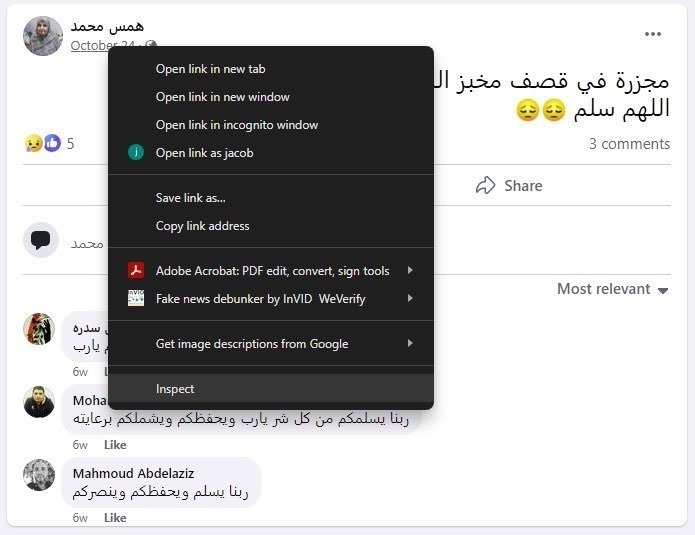

Verifying the Impacted Location & Analyzing the Destruction
The aforementioned Facebook post by al-Maghazi Now also included night photographs documenting the total destruction of the bakery and the adjacent buildings. These photographs capture what appear to be the initial moments after the attack. The caption accompanying the images states that “tremendous destruction befell al-Maghazi al-Jadeed Bakery, Hammadah Ice Cream Parlor, Aabed Money Exchange, and many shops and residential buildings caused by the bombing of the al-Barbarawi family’s house.” We conducted a search on YouTube to validate these claims; this led us to a video posted by the Alkofiya TV channel in April 2022 — almost one year before the bakery was attacked. The video contains images from a tour in the streets of the al-Maghazi camp in Gaza, featuring scenes of the al-Maghazi al-Jadeed bakery before it was targeted. Al-Maghazi Bakery’s façade in the video appears to be identical to its façade in a photo published by Ramy Abdu on X (formerly Twitter), which he claims is of the bakery before the attack.
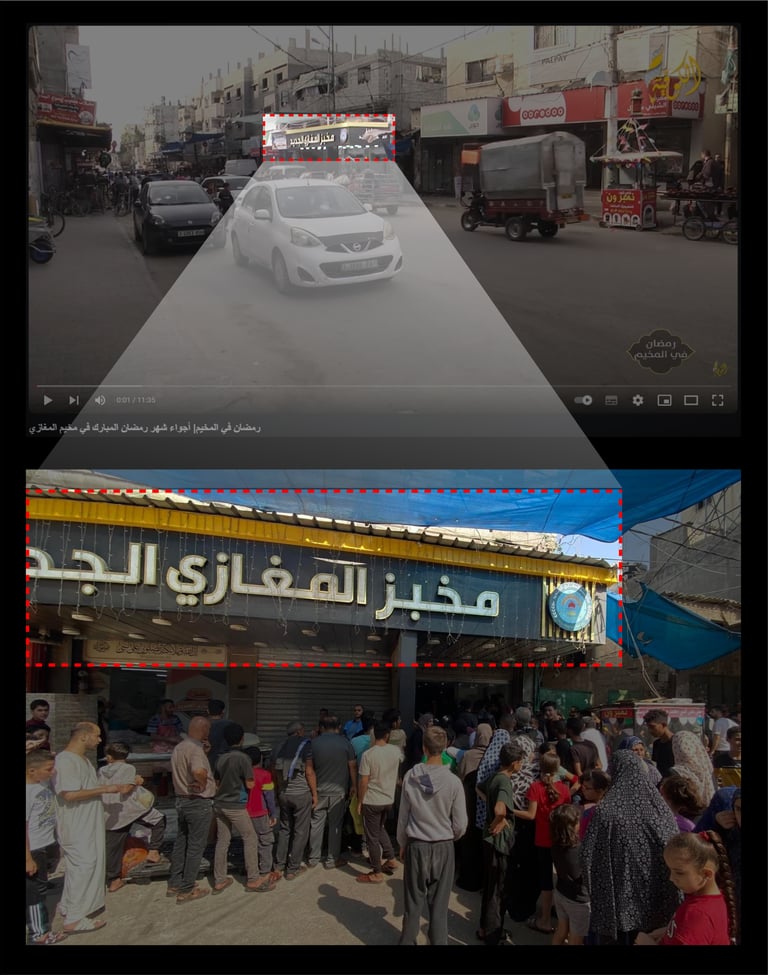

Above: A screenshot from a video posted by the Alkofiya TV channel on YouTube, showing al-Maghazi al-Jadeed Bakery before it was targeted. Below: A photograph posted by Ramy Abdu on X, showing al-Maghazi al-Jadeed Bakery before it was targeted. January 2024.
The location described in the caption accompanying al-Maghazi Now’s Facebook night photographs of the impact site, which was published after the attack was reported, aligns with elements seen in Alkofiya TV’s YouTube footage of the site, which was published a year before the attack. Alkofiya TV’s footage showed the al-Maghazi al-Jadeed bakery next to Aabed Money Exchange and other adjacent stores at the site of the attack.
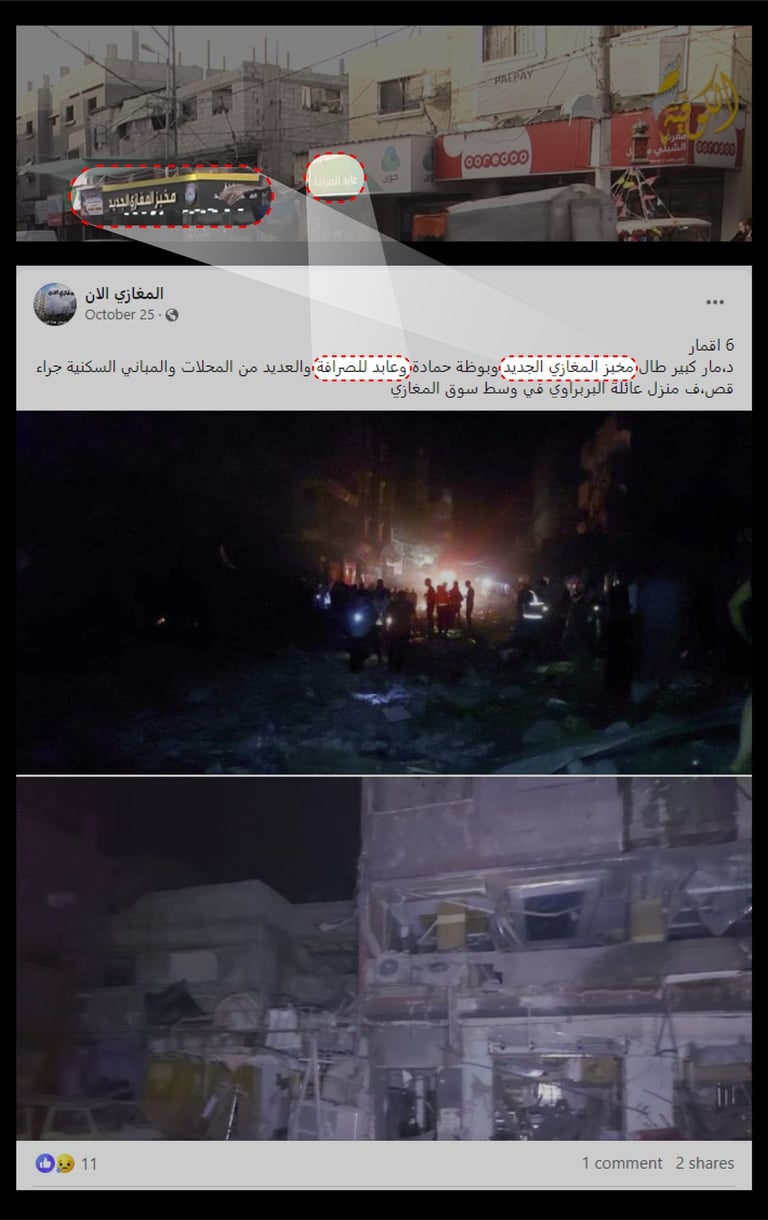

By searching through satellite images on Google Maps, we have identified what may be the possible impact location. A comparative analysis between three sets of images — satellite imagery of the site, photographs of al-Maghazi al-Jadeed Bakery before the targeting (published by Alkofiya TV channel on YouTube), and aerial images of the bakery after the targeting (published by Al Jazeera) — reveals that the prominent landmarks match across the different images, which verifies the accuracy of this location. To be precise, it is located in al-Maghazi camp, in the central market in the Deir al-Balah governorate in the center of the Gaza Strip, at coordinates (31.42197, 34.38353).


Screenshots of the affected site. Top left: A satellite image from Google Maps showing the location of al-Maghazi al-Jadeed Bakery. Top right: Photo of the site before the attack from the Alkofiya TV YouTube video. Bottom left: An aerial photo from Al Jazeera of the site after the attack showing the destruction and some prominent buildings that appear to match the authority with satellite images. Bottom right: A satellite image from Google Maps. January 2024.
Moreover, the location of the bakery and the identified features of nearby buildings match the features of the impact location visible in the aerial images published by Al Jazeera. This comparative analysis reveals that the crater made by the attack, which can be seen in the images documenting the impact, is situated precisely at the location of the bakery, indicating the possibility that the bakery itself was directly targeted.
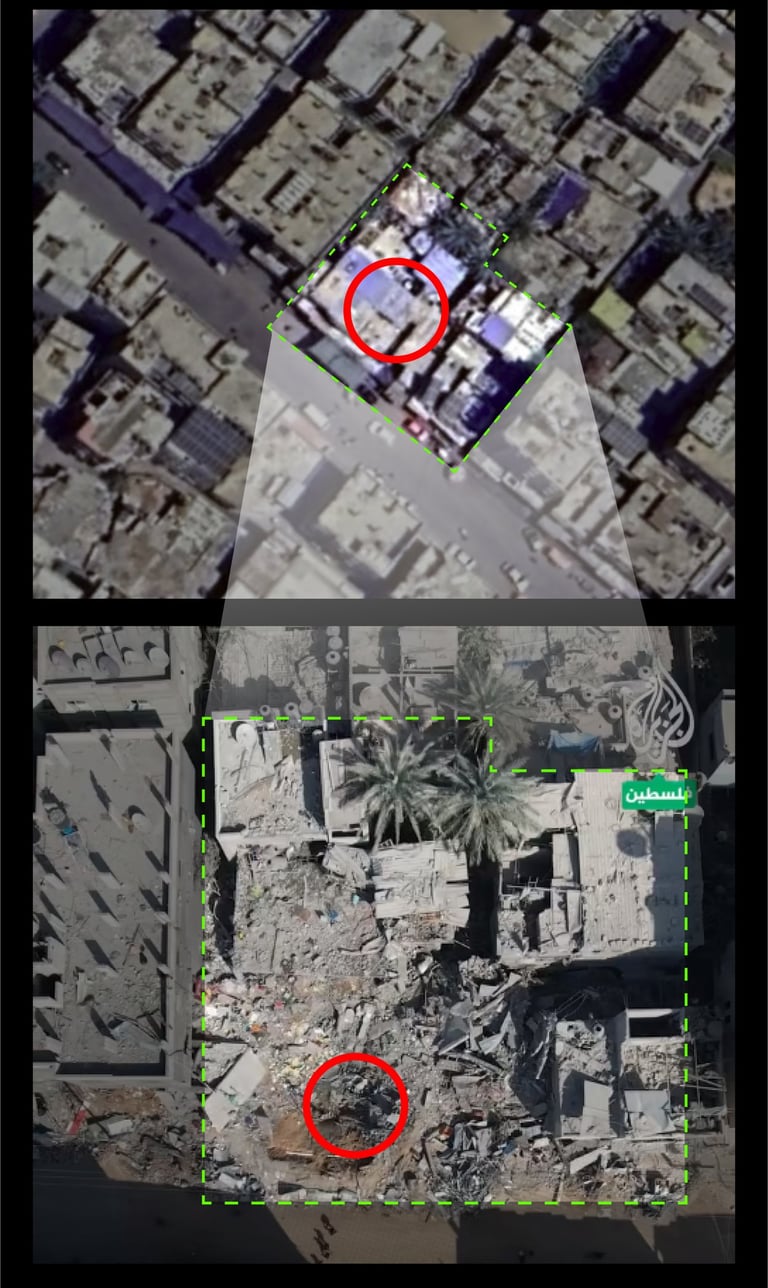

Above: Satellite imagery from Google Maps of the al-Maghazi al-Jadeed bakery. Below: An image of the affected site from the aerial footage published by Al Jazeera. Green square: Impact site of the attack. Red circle: Crater resulting from the shell hitting the bakery building.
A comparative analysis between satellite images from June 2022 and November 2023 reveals significant changes. The image from June 2022 shows the bakery as intact and part of the vital infrastructure in a densely populated area, while the image from November 2023 shows clear destruction in the location formerly occupied by the bakery and the crater made by the attack.
Two satellite images comparing the bakery before and after the attack, where the resulting crater can be seen. Photo Credits: (Before) Google Earth; (After) Planet Labs PBC
Specifying the geography is fundamental to analyzing the damage inflicted on the bakery, the level of destruction, and impact on nearby infrastructure. The bakery is situated in a densely populated area, making it an important, primary source of bread for local residents and displaced individuals.
Photos posted on al-Ray News Agency’s Facebook page, taken by Attiya Darwish, reveal the extensive damage inflicted on the bakery and the surrounding buildings. The images show piles of rubble, twisted metal structures, and a layer of dust covering the entire surface. It is evident the buildings adjacent to the bakery were also severely damaged: some had completely collapsed, while others turned to ruins. The state of the buildings, or what remains of them, indicates that the bombing on the area was intensive and that the strikes were concentrated there. This resulted in the complete destruction of the bakery and deeply impacted civilian infrastructure in the area.




The previous images, in addition to the aerial footage published by Al Jazeera, show a large crater that indicates the immense power of the explosion. This crater, formed in the vicinity of the bakery and adjacent buildings, reflects the force of the strike, the weight of the shell used, and its destructive impact on the infrastructure. The depth and breadth of the crater suggest that the weapon used had a high destructive capacity, making the situation more dangerous and complicating rescue and reconstruction efforts.
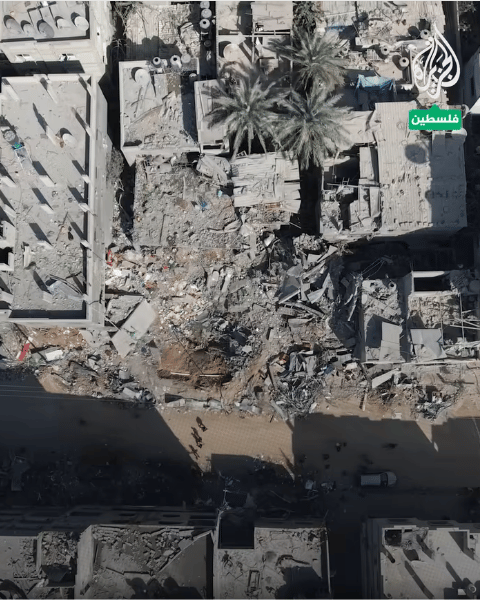

A screenshot from the aerial footage published by Al Jazeera reveals the size and depth of the crater from the airstrikes that targeted the site of al-Maghazi al-Jadeed Bakery.
As previously shown, we analyzed the crater and the destruction resulting from the attack, which available information and eyewitness testimonies described as being caused by an Israeli airstrike that directly targeted the bakery and caused extensive damage to the bakery site and its vicinity. We also analyzed more closely the crater to gain a better understanding of the incident. We concluded that the size of the crater resulting from the attack is approximately 13.65 meters in diameter and approximately 4.86 meters deep. We arrived at this estimation of the crater’s size by using the ImageJ tool to measure sizes; we took the average height of a person (about 175 cm) standing next to the crater — as shown in the first frame of a YouTube video showing the crater — for size comparison.
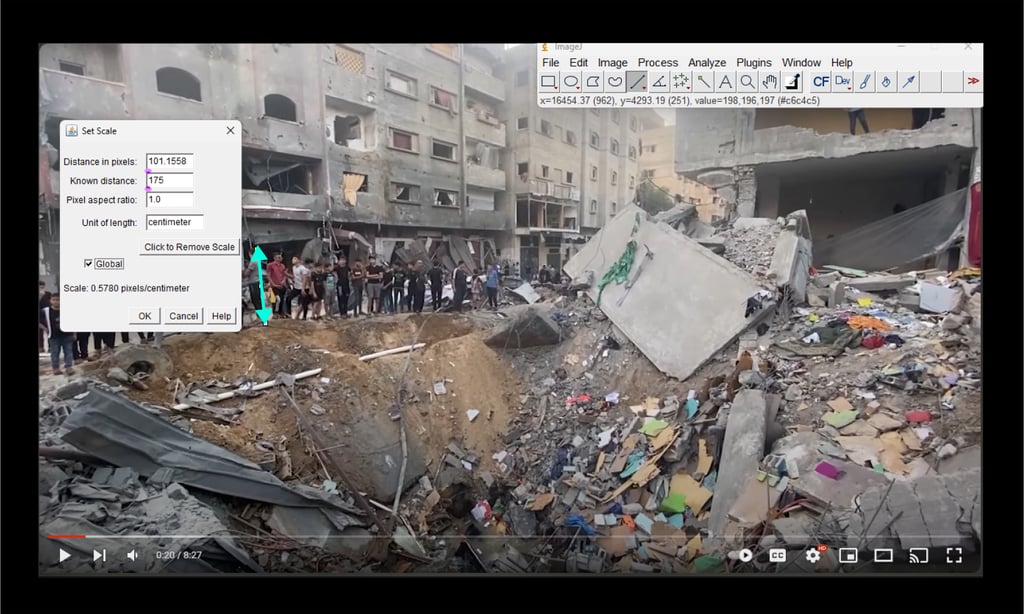

A screenshot from a YouTube video published by Wafa Agency. Bystanders in the video were used as a reference for measurement using the ImageJ tool.

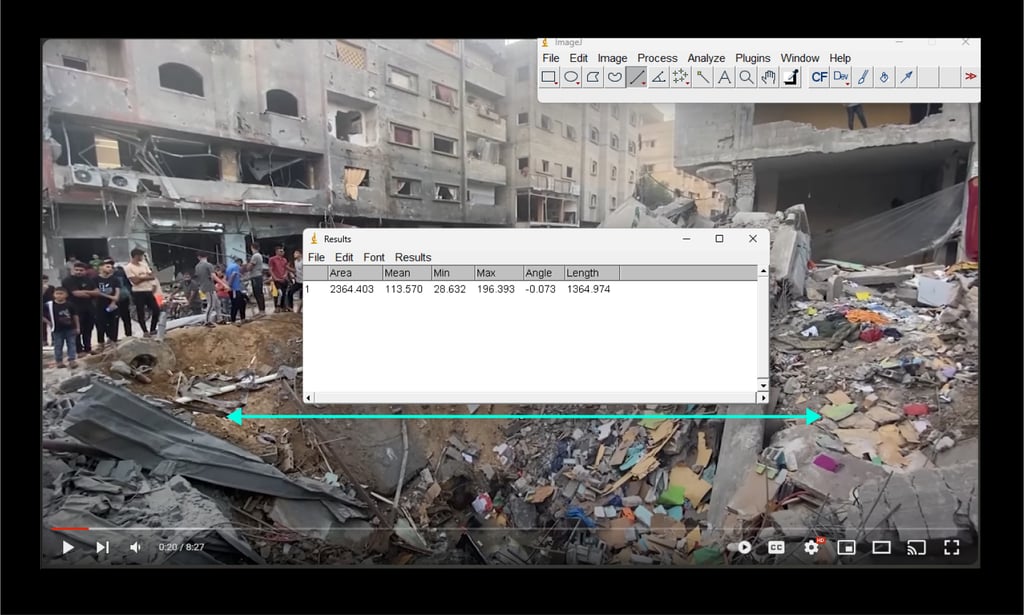


To ensure the validity of this estimate, we also calculated the crater’s diameter using one of Al Jazeera’s aerial photographs of the attack site. We were able to show the location of the impact by identifying the location of the crater in satellite imagery and by using the measurement tool available on Google Earth Pro. The result was similar to that achieved by using the ImageJ tool: the diameter of the crater was found to be approximately 13.65 meters.
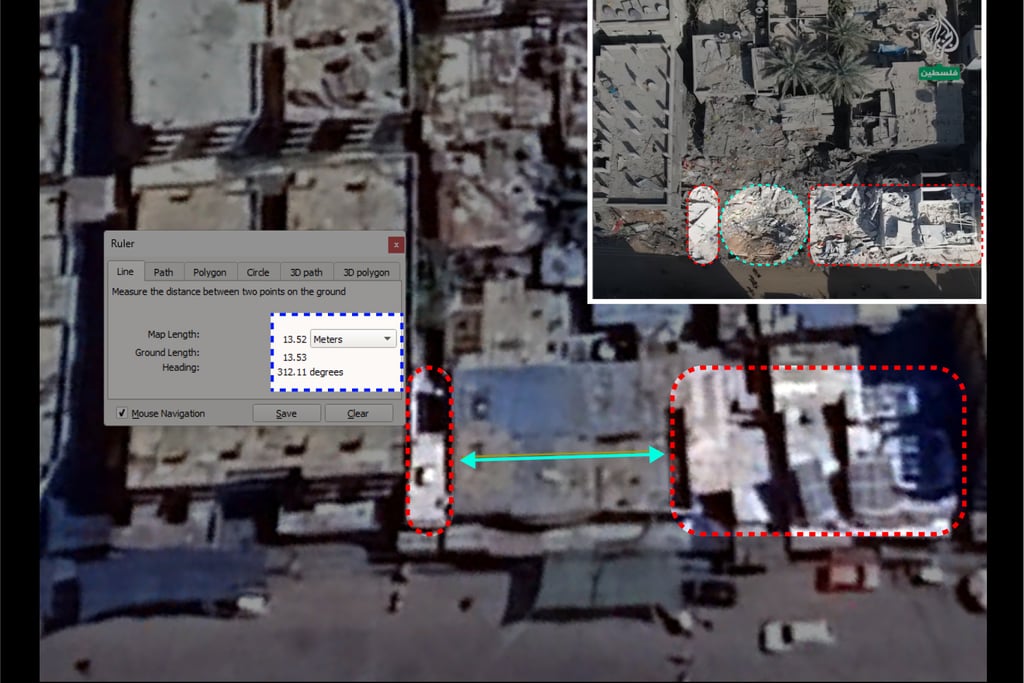

A comparison of the attack site, using a screenshot from one of the aerial photos of the attack site and the location of the attack site on Google Earth Pro, done by using a measuring ruler. The result shows the diameter of the crater is approximately 13.53 meters.
It is noteworthy to mention that this estimate is an approximation, and that a more accurate analysis will require specialized investigative units capable of accessing the attack site.
Based on our estimate of the 13.65 meter diameter and 4.86 meter depth of the crater, and according to the Armament Research Services (ARES) report on Explosive Weapons in Populated Areas, the damage resulting from the munitions that created the crater is consistent with the characteristics and effects of a large explosive weapon, perhaps 250-500 pounds (113-227 kilograms), which was likely an air-delivered munition. The scale and pattern of the destruction and the report’s technical analysis indicate that a high capacity air-delivered explosive bomb was used (page 49 of the report). This is consistent with our analysis of the destruction and eyewitness testimonies of the bakery's bombing and emphasizes the need for strict adherence to the principles of distinction and proportionality under international humanitarian law.
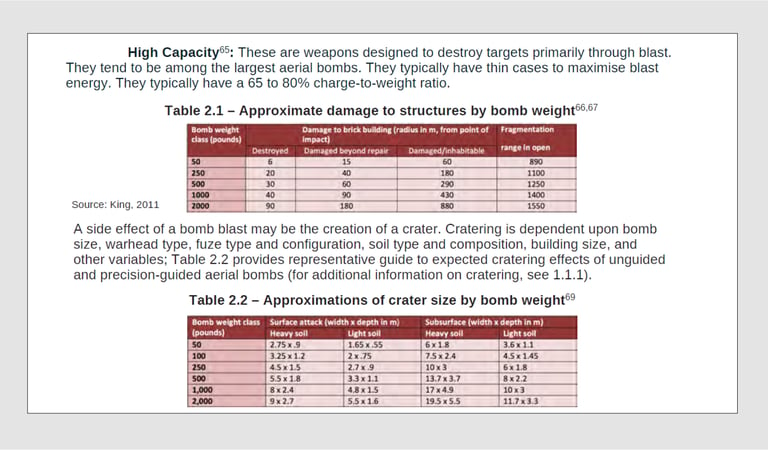

A screenshot of tables from page 49 of the Armament Research Services (ARES) report analyzing crater measurement and damage to infrastructure versus projectile weight.
This comparative analysis paints a clear picture of the material and human losses caused by the bombing, allowing the viewer to better understand the tragic situation in which residents of the camp find themselves in the aftermath of the attack. Visual evidence and personal testimonies are integral both to geographic verification and to analyzing the damage under investigation. They provide a deeper understanding of the impact which the airstrikes have had on civilian infrastructure and the humanitarian situation in al-Maghazi camp.

The Victims
Initial news reports indicated that the attack killed and wounded a number of people. The number of victims began to increase in the hours following the attack.On October 24, minutes after the attack, journalist Muthanna Al-Najjar reported via Telegram that five people were killed. But 35 minutes after the first post of the attack, on October 25, at 00:17, Al-Najjar posted again, confirming that the number of victims rose to seven. He included images of the emergency first-aid operations on the way to al-Aqsa Martyrs Hospital, which is in the area. Some of these images show the bodies of victims in shrouds, while others depict a wounded child covered in blood, receiving medical care.Shortly after the attack, Al-Araby TV also broadcast an interview with their regional correspondent who spoke in front of the hospital. The correspondent reported that the attack killed at least seven people, who were pulled from under the rubble, and that rescue teams were still trying to find more. The correspondent also mentioned that many were wounded, without specifying an exact number, describing the condition of some of them as critical.
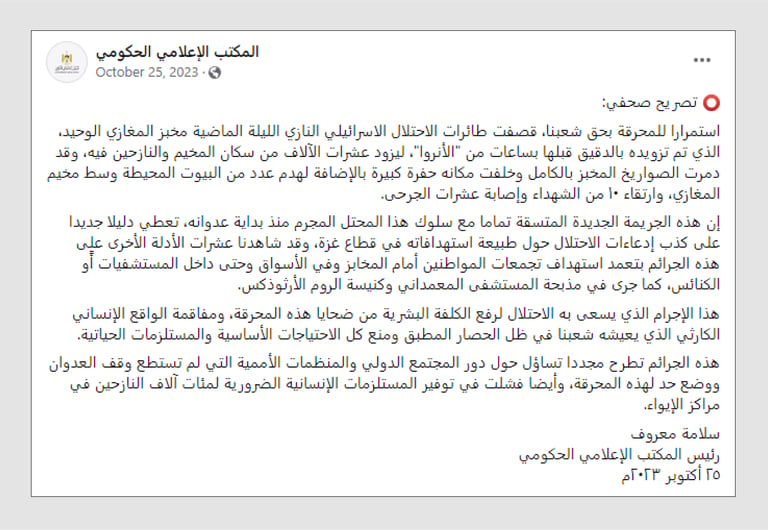

The next day, the number of victims rose to 10 , and a significant number of wounded were reported by Anadolu Agency and confirmed by activists on social media. Salama Maarouf, head of the Palestinian Government Media Office in Gaza, affirmed in a statement issued after the incident that the attack targeting the al-Maghazi al-Jadeed bakery resulted in the martyrdom of 10 individuals and “the injury of tens.”
A screenshot of the statement made by the Palestinian Government Media Office in Gaza on Facebook, about the bombing of al-Maghazi al-Jadeed Bakery. The statement says that ten people were killed and tens more were injured. January 2024.

The Impact of International Law & the Necessity of Independent Investigations
The repeated attacks on bakeries in the Gaza Strip, especially al-Maghazi al-Jadeed Bakery, which was targeted after receiving fuel and flour supplies from UNRWA, raises fundamental questions concerning Israel’s compliance with international law. Targeting civilian facilities, like bakeries, is considered a clear violation of international humanitarian law, given that it leads to severely punitive humanitarian consequences for civilians.International law, specifically Article 33 of the Fourth Geneva Convention, prohibits collective punishment and all forms of terrorism and intimidation, affirming that no protected person shall be punished for a crime not personally committed. Article 53 of the same convention also prohibits the destruction of public or private property, except in cases of absolute military necessity.While investigating and documenting the targeted attack on al-Maghazi al-Jadeed Bakery, we came across visual materials alleging other attacks on bakeries. We could not investigate or verify them like we did with al-Maghazi al-Jadeed Bakery, but there were at least five bakeries attacked between October 10 and November 1, 2023. These attacks reportedly targeted both al-Yazigi Bakery in Tal Al-Hawa and al-Wahat Bakery on October 10; Kamal Ajur Bakery’s al-Sedra branch on October 11, then the branch on Sheikh Radwan on October 16; al-Maghazi al-Jadeed Bakery on October 24; and two branches of al-Sharq Bakery in Jabalia and al-Nasr Street on November 1. It is gravely concerning that some of these attacks were directed at paramedics, which reflects a complete disregard to the fundamental principles of international humanitarian law.According to the Protocol I to the Geneva Conventions, Article 48 prohibits the targeting of civilian populations or civilian utilities as a military objective. Meanwhile, Article 51(2) prohibits acts or threats of violence primarily intended to spread terror among civilian populations. And Article 54(2) of the same protocol prohibits attacks on utilities that are necessary for the survival of civilian populations, notably foodstuffs and water facilities, for the purpose of depriving civilian populations of bare necessities.In this framework, these attacks on bakeries in the Gaza Strip may constitute a clear violation of these provisions, as bakeries are considered vital facilities that ensure food security and the survival of the civilian population. Not only do these attacks reflect a neglect of legal duties, but they also reflect an indifference towards the ensuing grave humanitarian consequences.Based on these facts, there is an urgent need for independent and transparent legal investigations to determine whether these actions constitute violations of international laws and to hold accountable those responsible for these actions. This challenge requires serious and concerted efforts from the international community, not only to achieve justice but also to ensure the protection of civilian populations in the future.

Methodology
Data Collection: Video segments and images from social media and news websites that were published on the day of the attacks and in the following three days were gathered, saved, and analyzed. The investigation used a total of 34 sources across various media.
Timeline Verification: The date and time of the attack were determined through advanced searches on Facebook, including the use of the WhoPostedWhat tool, advanced searches on X (previously Twitter) and Telegram, diverse search engine queries, and Epoch, which is an open-source tool for accurately verifying dates.
Verifying Geographical Location: The geographical location of the al-Maghazi al-Jadeed bakery was determined by searching on satellite imagery providers, such as Google Maps and Google Earth, and comparing the results with published images of the attack before and after it took place.
Comparison: Visual materials from social media showing the destruction at al-Maghazi al-Jadeed bakery were matched with recent satellite images of the location in order to add a second layer of verification for the investigated attacks. ImageJ and Google Earth were used to calculate an approximate measurement of the size of the crater created by the attack.
This investigation is the result of an analysis of open-source information that was carried out over different stages to provide data on the date, time, and location of the incident. Nevertheless, based on a comprehensive review of all available information on the targeting, the investigator could not determine the type of munitions used or the entity that is allegedly responsible for the attacks.

